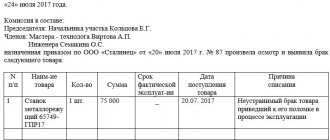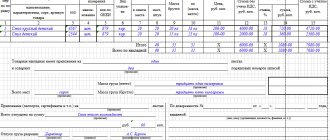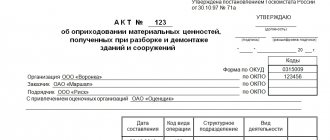Certificate of shortage of goods upon acceptance: sample, form, form
In order to properly receive the goods, you must be responsible about the procedure for receiving the consignment of goods. For this, there are generally accepted instructions that should be followed in order to subsequently avoid problems with inspection authorities.
General information
Usually the goods are accepted by employees who are financially responsible. Such employees are approved by management and undergo special training. Their responsibilities include drawing up all the necessary documents related to the acceptance of goods in terms of quantity and quality. They have the right to sign:
- acceptance certificates;
- acts of shortage;
- return certificates;
- other acts.
Employees of the trading company are responsible for the correct completion of all documents of material value and the deadlines for their execution.
This video will tell you in more detail about what to do if a shortage of goods is detected:
Functions and role of the document
A shortage report is drawn up in the event of a discrepancy between the quantity of goods indicated in the invoice from the supplier. This is usually discovered upon receipt of a shipment of goods. Therefore, you need to be very responsible when accepting products. It is worth checking the availability of goods with transport company employees or representatives of the supplier.
- Shortages may occur due to the fault of the supplier or due to damage to property during transportation, improper packaging, or the delivery of incomplete goods.
- The act of shortage must be reflected in the financial statements of the enterprise. This is one of the important functions of such acts.
- In addition, shortage acts make it possible to recover monetary compensation from the guilty party for damage to property, as well as resolve controversial issues with the supplier.
If this document is used correctly, the company will be able to protect its rights in court if the need arises.
Regulatory regulation
In order to correctly draw up various acts, it is worth referring to the regulatory documents establishing the procedure for filling out such documents.
- TORG-2 is filled out when the goods are received. It must be prepared in 4 copies;
- TORG-3 is drawn up in cooperation with foreign partners in 5 copies;
- TORG-12 takes into account goods subject to return and lists missing products.
The video below will tell you about the transactions for writing off shortages of goods:
How to correctly draw up a report of shortage of goods upon acceptance
- First you need to print out the shortage report form. It can be found on the Internet or taken from the accounting department.
- After this, you need to, together with a representative of the company that provided the goods, check the availability of item names.
If a manufacturer’s representative is not available, then it is necessary to invite a representative of the transport company that delivered the products or an independent expert. - If a shortage is discovered for different suppliers, then for each supplier a separate document is drawn up with a list of missing items.
It would be nice if a photo or video report was also attached along with the act. - If upon receipt an incomplete item is discovered, it can also be included in the list as a shortage.
In this case, it is necessary to ensure that such goods are stored in a place that will not deteriorate its condition. It must be stored if the supplier is ready to complete it within the time limits required by law. - To avoid any questions, it is advisable to ask a representative of any other independent company to be present during the inspection.
- Along with the deficiency report, you must immediately prepare a claim in which you indicate possible options for resolving the situation.
They can be expressed in the following ways:- You require delivery of the goods paid for and stated in the invoice;
You agree with the quantity of products you received. You demand a refund of the difference in funds paid by the amount of the shortfall;
- If the goods have been paid for, you demand a refund of the entire amount of money provided that you reject the entire shipment of goods.
The act must indicate the date the document was drawn up. The report must be sent to the supplier as quickly as possible, since it is necessary to meet the deadlines required by law. Otherwise, the supplier may refuse to fulfill the claim.
The form (form) of such an act can be downloaded here.
Sample report on shortage of goods upon acceptance
The deficiency report is signed by all members of the commission. Each copy must have a living signature of all participants.
What to do next with such a document
- After drawing up the deficiency report, you need to send it by mail or via the Internet or fax to the supplier for review and decision-making.
- One copy must be given to your accounting department for safekeeping. There they are required to file it in a folder of similar acts and store it for 3 years.
Even more useful information on the issue of surplus, shortage, and misgrading of goods is contained in this video:
Source: https://uriston.com/kommercheskoe-pravo/dokumentatsiya/akty/tovary/o-nedostache-tovara-pri-priemke.html
Report of shortage upon acceptance of goods: form
There is no single, mandatory form for a report on identified shortages of goods. Therefore, an organization can develop such an act independently, taking as a basis, for example, form No. TORG-2 “Act on the established discrepancy in quantity and quality when accepting inventory items” (approved by Resolution of the State Statistics Committee of the Russian Federation dated December 25, 1998 No. 132). Whatever version of the act the organization chooses, it is important to ensure that such primary information contains the required details (Part 2, Article 9 of Federal Law No. 402-FZ of December 6, 2011):
- Title of the document;
- date of document preparation;
- name of the economic entity that compiled the document;
- content of the fact of economic life;
- the value of the natural and (or) monetary measurement of a fact of economic life, indicating the units of measurement;
— the name of the position of the person (persons) who completed the transaction, operation and the person(s) responsible for its execution;
- signatures of persons indicating their surnames and initials.
As a rule, the act will be signed by the purchasing organization and representatives of the transport organization. Of course, it would be better to involve a representative of the seller in signing the act, if possible, and also to include a representative of an independent organization among the persons who drew up the act. Accordingly, the number of copies required is equal to the number of parties involved. Typically, such an act is drawn up in 3 copies - for the buyer, the seller and the transport organization.
The form of the act on the identified shortage of goods used by the organization must be fixed in the Accounting Policy for accounting purposes.
An example of a form for a statement of shortage of goods upon acceptance can be downloaded from the link below.
Report of shortage of goods upon acceptance (Word): .
We also provide a sample of how to fill it out for a statement of shortage of goods upon acceptance:
Prev. / Next
Download the cargo shortage report. Act on shortage of goods during inventory (sample)
Report of discrepancy (shortage of goods) form TORG-2
filled in when a discrepancy is detected between the actual goods received and those indicated in the documents. How to fill out the TORG-2 form correctly? We bring to your attention a completed sample of the act of discrepancy; you can download it from the link at the end of the article. There you can also download the TORG-2 form itself.
So, you are the organization receiving the goods.
When accepting the goods, you check its quality, integrity of packaging, appearance, commercial properties and the amount of material assets received, and compare everything with the attached documents.
If at the same time you discover any violations: shortages, surpluses, mis-grading, inadequate quality of goods, then you need to document all this immediately, before the driver leaves.
What documents need to be drawn up?
First of all, this is the “Act on the established discrepancy in quantity and quality when accepting goods and materials”: if domestically produced goods are accepted, then the act is in the form TORG-2; if imported, then form TORG-3.
Based on the completed discrepancy report, a claim for the product is filed, and all this is submitted to the supplier for consideration. A sample claim for a product can be viewed.
Sample act of discrepancy form TORG-2
The act form consists of 4 sheets.
On the first sheet you need to reflect general information about the recipient organization, indicate the place of unloading of the goods, on the basis of which document the goods are accepted (for example, a bill of lading or a bill of lading). Next, the details of the supplier organization and the place where the goods are loaded are written down. The necessary information about the transportation of goods and their unloading is also written down.
The second and third sheets reflect directly identified inconsistencies: packaging violations, shortages, surpluses, etc.
The last sheet is the final one, it sums up the results and writes the conclusion of the commission that verified the correspondence between what was actually received and what was indicated in the documents.
All members of the commission must sign the act.
The document is assigned a number, the date of preparation is indicated, and the head of the organization puts his signature on the first sheet, thereby approving the document.
filling out a statement of discrepancy / shortage of goods
If the goods are accepted into the warehouse, and later discrepancies with the documents or defects are revealed, then in this case a statement of discrepancies in quantity and quality is also drawn up; it does not have a unified form and is drawn up in any form. You can use the existing TORG-2 form as a sample.
A claim for the goods is also drawn up along with the drawn up act; both documents are sent to the supplier for consideration. Based on the supplier's decision, further actions are taken to correct all violations.
The case of returning goods is discussed in detail in, where you will find out which entries should be made by the supplier’s accountant and which by the buyer’s accountant.
https://youtu.be/AsEh_s-QKIY
Documents of the enterprise's office work → Statement of shortage and (or) misgrading of goods
Act
No. from "" 20
about shortage and (or) misgrading of goods
1. name of the organization 2. full name of the authorized person...
- Sample
.
Act
control check of correct loading of products (
goods
)Contract for the carriage of goods and passengers → Sample. Certificate of control verification of the correct loading of products (goods)
Act
control check of the correct loading of products (
goods
) name and details of the enterprise: “” 20, no... - Sample
.
Act
for damage, fight, scrap
goods
(material). Form No. 12Accounting statements, accounting → Sample. Act of damage, damage, scrap of goods (material). Form No. 12
Its markdown (write-off) due to the material. (damage, battle, etc.) as a result of the inspection it turned out: – no. quantity actor
markdown sum pre- +- +-markdowns skur.name of
goods
, sorted.gross netto price sum newamount or materials, art... - Sample
.
Act
for transmission
goods
, containers and equipment when changing bartendersAccounting statements, accounting → Sample. Act on the transfer of goods, containers and equipment when changing barmen
Okud code 0903115 (enterprise, organization) act
no.
for the transfer of goods
, containers and equipment when changing bartenders on 20. handing over: receiving: (position, function... - Sample
.
Act
about detection of shortage of products (
goods
) when opening a carriage (container, van)Contract for the carriage of goods and passengers → Sample. Report on detection of shortage of products (goods) upon opening of a carriage (container, van)
Act
about the discovery of a shortage of products (
goods
) when opening a car (container, van) “” 200, place of compilation... - Sample
.
Act
about the established discrepancy in quantity when accepting imported
goods
. Specialized form No. 2-onAgreement for the supply of goods and products → Sample. An act on the established discrepancy in quantity when accepting imported goods. Specialized form No. 2-on
specialized form no.2-on +-+ code according to okud 0903002 +-+ “I approve” “” 20 act
no.
dated “” 20 about the established discrepancy in quantity when accepting imported goods
place of drawing up
the act
: ... - Sample
.
Goods
inventory act
Source: https://kapitalists.ru/download-the-certificate-of-shortage-of-goods-act-on-the-shortage-of-goods-in-inventory-sample.html
Instructions for filling out the act
This act is filled out in the following order:
- First, fill out the header of the act: indicate the full and abbreviated name of the organization, its address, contact phone number, as well as the name of the unit.
- After this, fill out the small plate located on the right. It contains OKVED and OKPO codes, as well as the date the document was compiled and its serial number.
- Then you can proceed to filling out the main field of the act in case of shortage of goods during inventory. It is necessary to indicate where the goods were received (for example, in a warehouse). The report can only be drawn up after the commission has completed its inspection.
- If a defect or shortage of products is discovered, it is necessary to call the sender of the goods. To do this, you need to send him a letter by mail or fax. Information about the notification must be noted in the act.
- The act must include the details of the sender of the goods, the manufacturer, the seller and the insurance company (if the products are insured). You also need to enter the date and number of the supply contract and the numbers of all accompanying papers.
- You must indicate how the goods are delivered; point of departure and point of arrival; time of loading and unloading of products. All information is taken from the invoice for the goods.
- After this, the delivery information is filled in. The following information is entered into the table: type of packaging, cargo weight, number of pieces.
- The following table shows the actual data and identifies any discrepancies. The date the package was opened is indicated.
- After this, the methods used to identify inconsistencies are indicated. All defects and possible reasons why they could appear are described in detail.
Inventory shortage, what to do?
Sometimes during the inventory process, a shortage or surplus of goods is identified. What actions should an institution take during an inventory and how to compensate for the resulting damage? Is it possible to use surplus goods or write off their quantity identified in the shortage category?
Report of shortage of goods upon receipt of goods
First of all, if a shortage of goods has been identified, you need to draw up a document confirming the violation of the terms of the custody agreement. The shortage report is considered an official document that reflects the exact quantity of goods that do not correspond to the invoices.
A similar document is created not only when sending or receiving goods. If the norm is not exceeded, the missing products are written off. If the quantity exceeds the final product, responsibility falls on those who store the product or are responsible for its loss or damage.
In this case, the losses are reimbursed to them.
Sample of an inventory act
Sample order to withhold shortages based on inventory results
If accounting indicators and inventory data differ, a statement is drawn up. It is a document that reflects all inventory totals in the event of loss of accounting information. The amount of shortage or surplus of products in such statements is noted according to a similar accounting scheme.
Based on the final results of the activities of the commission, which draws up the protocol, the employer makes a decision on compensation for damage. An appropriate inventory order is created and funds are withheld from the guilty parties.
Sample order
Write-off of shortages in the absence of culprits
If the existing measures taken by the company did not allow identifying the responsible or guilty persons, then the total amount of the shortage of goods is written off based on a previously created order.
If the total amount turns out to be higher than the current profit rate or the rate for the missing property is not approved, then the shortage is debited according to account number 91. In other words, it refers to other expenses.
VAT from an account that was previously accepted for deduction does not need to be restored, since the Tax Code does not mention in its own accounting the situation when this coefficient is subject to restoration.
At what price is the write-off of shortages based on inventory results reflected?
Compared to the previous year, there were no changes in tax accounting. To consider the correct write-off based on inventory results, an example should be given.
Example:
When conducting an inventory at a wholesale company, excess goods were discovered. Due to the lack of primary documents for a similar product, a third-party company was involved in the cost. The cost of goods that were in surplus was estimated to be 3.5 million rubles. The cost of the appraiser's services amounted to 249.6 thousand rubles, including VAT of 41.6 thousand.
Dismissal of a materially responsible person due to shortages
If the employer has identified the person responsible for the shortage, he has the right to fire him. As a rule, this is done at will. To do this, you need to notify him 14 days in advance of your dismissal.
If there are no grounds for detaining an employee, this can be done immediately.
However, within a two-week period, the employee must transfer the values for which he is responsible under the employment contract
Material assets are transferred on the basis of an acceptance certificate.
During the period of signing the act, the agreement on material assets terminates its validity in the event that the employee does not consider it a financially responsible person.
When transferring valuables, the employer must do so within a two-week period. If this has not been done, the head of the company will no longer be able to detain the employee.
Explanatory note on shortage
This type of document refers to official personnel types. It must be submitted either to the HR department or to the manager’s secretary.
The explanatory note is drawn up by hand or on a special sheet in the form of an internal regulatory act of the enterprise. Includes two basics:
At the same time, employees ask that all documents be written by hand. This protects against accusations. There were situations when employees did not recognize the explanatory note they had written on the computer.
If you have questions, consult a lawyer. You can ask your question in the form below, in the online consultant window at the bottom right of the screen, or call the numbers (24 hours a day, 7 days a week):
Source: https://classomsk.com/alimenty/zadolzhennost/nedostacha-pri-inventarizacii-chto-delat.html
How to draw up a deficiency report
In the activities of any enterprise there is such an income item as the purchase of inventory items from third parties.
Inventory and materials are purchased and accepted according to a special procedure in compliance with established rules and regulations.
If a surplus or shortage of goods is detected, this fact is documented. Drawing up a report on the amount of the identified shortage of goods and materials is the responsibility of the storekeeper or other employee authorized to receive goods. This form is also used when a shortage is detected during the audit of valuables stored in the organization.
Cases when an act is drawn up
Inventory and materials are always accepted and stored by employees who, according to documents, are responsible for their acceptance and further safety. Organizations enter into agreements with such employees on full financial responsibility. Such an agreement gives the employee a number of powers, but at the same time increases the degree of responsibility to the maximum.
When accepting commodity valuables, an authorized employee is obliged to check their quantity and quality, and based on their results, the following is drawn up:
- Acceptance certificate, if no inconsistencies are identified and there are no complaints.
- Certificate of return, if damage to all or most of the delivered products is detected.
- Shortage report, in case of short delivery.
- An act of discovered surplus, if the receiving party wishes to take the excess for itself.
Any document is drawn up according to strictly established standards, with a clear indication of the reason for its writing and written testimony from both parties.
A deficiency statement is a document that is drawn up in various cases:
- The accepted batch of goods does not correspond to the quantitative parameter specified in the delivery note.
- The Audit Commission discovers discrepancies between the balances of goods indicated in the list and the actual quantity in the warehouse or other premises during the inventory.
- Insufficient money was detected in the organization's cash register or in the bank package.
The deficiency report can be expressed in various units of measurement: weight, pieces, monetary amounts.
Who draws up the document
Typically, storekeepers are responsible for the acceptance of goods, if, of course, such a unit has been introduced in the organization. If the company is small, and the supply of goods and materials is not regular and is taken only for its own needs, then such a responsibility can be assigned to any other employee. The main thing is that the person who accepts the values and is responsible for their storage is distinguished by the following:
- His job description clearly states that he has such obligations.
- An agreement on full financial responsibility was concluded with him.
In the absence of an employee authorized to accept him, his duties are performed by the employee who is required by position to replace him.
Such strict rules make it possible to establish inventory accounting and be able to subsequently strictly ask for identified inconsistencies.
The document on the shortage is drawn up by the responsible employee, most often it is:
- Storekeeper.
- Cashier.
- A specially appointed audit commission.
Unlike the storekeeper and cashier, the powers of the commission are not permanent; they are limited not only by time, but also by space. The commission is appointed to check inventory items in the warehouse or cash in the cash register or check the availability of equipment and in other cases, but within strict limits.
Design rules
When accepting goods, the storekeeper or other responsible person is obliged to carefully check all the items specified in the technical specifications with their actual shipped quantity. Before the goods and materials are verified in terms of quantity and quality, a signature on acceptance of the goods is not affixed to the TTN.
If the recipient was able to detect a shortage or identify damage to part of the delivered products, then he must adhere to the following registration rules:
- Print the required document form.
- Determine the exact amount of shortage. The form can include not only missing positions, but also those that are incomplete.
- The form must be filled out only in the presence of the other party's representative.
- Together with the deficiency report, a claim is drawn up, in which the recipient indicates possible ways to solve the problem.
- If there are several suppliers at the same time, then the document is issued for each representative separately.
If there are disagreements regarding quantity or quality, other representatives, for example, a transport company, are invited.
Form and content
There are several different forms of acts of inventory deficiency:
- TORG-2, the most common form, is used when discrepancies between values are detected upon acceptance. Written in four copies.
- TORG-3 will be needed by those organizations that cooperate with foreign organizations and purchase goods from them. Filling out is done in five copies.
- TORG-12 combines two functions - it lists inventory items that need to be returned due to quality inconsistencies or excess, and also simultaneously provides a list of missing values.
Each of them is filled out taking into account individual characteristics, but moreover, all three forms have much in common.
When filling out the form you must indicate:
- The name of the receiving organization on whose behalf the document is being drawn up.
- Legal and actual address, contact telephone numbers.
- The basis for acceptance, the number and date of the technical specification according to which the acceptance was carried out is indicated.
- Form number and date of completion.
- Reception location.
- Details of the supplier company, shipper or other intermediaries.
- Supply contract data.
- Where did the product come from?
- Date and time of arrival of inventory items.
- First, all data from the technical specification is entered into the table, and then the discrepancies are recorded, with the obligatory indication of packaging and quantitative calculation.
- The second page records the methods that made it possible to detect inconsistencies, such as weighing, measuring, etc.
- Indicate all detected defects, if it is not just a complete absence.
The form itself is signed by the storekeeper and the supplier’s representative, and then approved by the signatures of the chief accountant and director of the enterprise.
Sample documents
Shortage statement – form
Source: https://znatoktruda.ru/otvetstvennost/akt-o-nedostache/
What to pay attention to
When checking the availability of goods and valuables at the enterprise for the current period, the financially responsible person and the composition of the commission need to take into account a number of features of the procedure and filling out INV-3. Five features of the inventory procedure and filling out an inventory report:
- When checking, sometimes they use an audit form drawn up in their own hand. But the form contains the details from the unified form. But there are exceptions ─ budgetary organizations, for which the unified INV-3 format is required to be filled out.
- A commission approved by the head of the enterprise or another person who initiated the audit participates in the audit.
- The recording protocol is an appendix to the corresponding order. Therefore, without the announcement and writing of the latter, the act has no legal force.
- Identified inventory items that are not taken into account by accounting are also included in the inventory list.
- If goods are discovered that have become unsuitable for further use, an appropriate protocol is drawn up with a list of found goods and materials.
The form, which records the results of the inventory of the enterprise's inventory, is mandatory to be filled out only by budget-funded enterprises, and the rest - at the discretion of management. When filling out the form, participants must rely on the legislation of the Russian Federation. Therefore, you should first review the completed protocol templates. It is also worth using a unified form, as the required details are indicated there.
Back to contents
Shortages during inventory and its registration
An inventory shortage is usually called a shortage of commodity or material resources that exceeds acceptable spending standards.
Concept and features
In order to ensure the veracity of accounting indicators and all data in reports, it is imperative to conduct a complete inventory of commodity and material resources at the enterprise. It is during this procedure that you can make sure that all existing values are really present (the coincidence of a particular resource with its presence in the accounting register).
All discrepancies that may be identified during the inventory must be recorded in the financial statements.
There are different types of shortages, which depend, first of all, on the degree of the discrepancy itself and on the type of material value of the resource. Let's look at the types of shortages:
- Lack of normal limits. The following indicators are considered the norm (for goods):
- 0.1%: non-food products;
- 0.25%: food products;
- 0.3%: goods distributed in large trading areas with an area of 350 square meters or more.
- Shortage-re-grading. According to the instructions, surpluses and shortages due to misgrading are possible only within the framework of goods with the same names, during the same inspection period and by the same inspector.
- Lack of non-current assets. In cases where there is a discrepancy between the actual and registered values of non-current assets, it is customary to write off the shortfall, thereby reducing the primary price of the assets. This is done using entries in the debit of account 13 “Depreciation”.
- Lack of securities. Deficiencies of this type are discovered, as a rule, when they are issued in documentary form. In cases where shortages of shares lead to loss of rights to them by investors, the securities are sent to the expense column.
The video below will tell you what an inventory shortage is:
First steps
Once an actual resource discrepancy is discovered, the first thing to do is determine the cause of the leak.
Often, it turns out that there is actually no shortage, and the accountant’s mistake is to blame. This happens most often when, after the goods have been shipped, the operation is not documented.
As a result, goods are not discovered in the warehouse, which according to the papers should still be there.
If the accounting reports are correct, a shortage still occurs, it is necessary to understand the cause of the shortage, conduct an investigation, force the employee to draw up a deficiency report and recover the lost funds.
Act and explanatory
According to the law, in the event of a shortage, management not only “may,” but is also obliged to require an explanatory note from the employee. In this case, according to labor legislation, the subordinate does not have the right to refuse to write an explanatory note; he is obliged to present the problem within two working days.
The deficiency statement must be written in the name of your immediate supervisor (executive, financial or general director).
The act must contain:
- Descriptions of all the moments and situations that led to the shortage. Example: “On March 14, an inventory check took place at the Izona warehouse. As a result of the inspection, a shortage was discovered in the composition...”
- Description of the reason for the shortage. There should be no long and detailed explanations here; just the facts.
- Details of the act. Here you must enter all the formal data - the name of the company, the name and surname of the manager, the position of the employee, the name of the act (Explanatory Note), date, initials and signature of the employee.
The act form can be downloaded here.
Sample report on shortage of goods during inventory
Writing off shortages in 1C Accounting is the topic of this video:
All the subtleties of the incompatibility of actual property with planned property must be reflected in this way:
- The numerical amount of the shortfall must be written off from the account. For this purpose, it is not the price of the product that is used, but its cost. You can often notice how shortages are written off at the external price; this is a gross violation.
- The calculation of the parts of the shortage must be established by management.
- All shortages must be reflected in account 94 “Shortages and damage to resources.”
- Note the shortage in the debit of account 94 “Shortage and damage to resources.”
- Note in the reporting deviations from standard natural losses.
Responsibility
According to Part 2 of Article 247 of the Labor Code of the Russian Federation, if an employee of an enterprise is a financially responsible person and at the same time a shortage is discovered, he must write an explanatory note. Otherwise, his actions are recorded in the act. Prosecution takes place according to the following stages:
- The employee is notified that management requires an explanation for the shortage.
- If the employee has not done this, then he must receive a notification and sign up for it.
- If the employee has not signed or does not want to do so, then in the presence of witnesses, this notice is read aloud to the employee.
- If the employee, despite this, does not explain the situation, then a document is drawn up confirming the person’s refusal and evasion of explanation.
Sample act
A sample statement of shortage during inventory is given below:
Similar articles
- Rules for conducting inventory in a store
- Act on shortage of goods during inventory (sample)
- Inventory results report (filling sample)
- Form OS-14 (equipment acceptance certificate)
- Form OS-16










